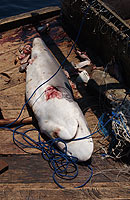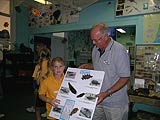Victoria: A Shark on the Critical List - The Grey Nurse Shark (Carcharias taurus)
Mark Rodrigue, MESA Victoria
What can we do to protect the Grey Nurse Shark from becoming extinct?
1. Habitat Protection
Protecting habitat critical to the survival of the Grey Nurse Shark is probably one of the most effective means to halt the decline of this species and provide some opportunities for the numbers to recover.
In a number of places where protection of the area known to be important for Grey Nurse Shark is established overall numbers of sharks using the locations have improved slightly and the time of year that they occupy the area has increased.
At Fish Rocks near Coffs Harbour NSW Fisheries have closed an area to all line fishing and reduced the number of species of fish that can be taken from the area. Since the fishing closures at Fish Rock, Grey Nurse Sharks are now found to aggregate from May to February whereas prior to the fishing closures Grey Nurse Sharks were only found from May to November. The numbers of Grey Nurse Shark and aggregation period has increased because their food sources (mainly jewfish) have been protected from fishing impacts (commercial drop lines and spear fishing).
Further protection is still required around Fish Rock as up to 75% of the Grey Nurse Shark population at the site has been found to exhibit line fishing related injuries and there have been several reports of recreational fishers catching Grey Nurse Sharks.
|

A Grey Nurse Shark
with fins removed |
The community can get involved in supporting these fishing closures to protect more habitat and allow for recovery of this species. More work is still required to identify other sites that are critical for Grey Nurse Sharks and this need to be carefully considered for providing greater protection form both recreational and commercial fishing.
2. Research Activities
There are still many gaps in our knowledge of Grey Nurse Shark biology, where they breed, their ecological requirements, population numbers, abundance and distribution, and the effects human activities may have on their populations. The ability of managers to make informed decisions about the best way for recovery of Grey Nurse Shark populations is limited by this lack of knowledge.
Surveys of animals are needed to get a clear picture of the populations and will need to involve both fisheries scientists and the dive community in collecting information about where these animals are found. Tagging studies of individuals, which involve placing a unique identifying tag on the animals body so it can be recognised, provides information about the movement of animals, population size, growth rates and mortality rates for the species.
|
Information about change in population sizes from one year to another, migratory patterns of behaviour, localised movements and possible home ranges can help managers to consider what is needed in the size of protected areas and can also help to identify alternative forms of protective management.
3. Community Involvement and Education
Community involvement, education and support are a key part of any recovery plan for the Grey Nurse Shark. The bad image of the sharks in the past has been a major reason why they are now in decline. Better understanding that Grey Nurse Sharks are not a threat to humans is critical and programs run by public aquariums that promote awareness of the Grey Nurse Shark, its behaviours, and threats to the survival of this species play an important part in helping the community understand why habitat protection for sharks is urgently needed.
There is still however a need to increase public awareness about the Grey Nurse Shark, particularly for recreational fishers. There is some evidence that young Grey Nurse Shark are killed by recreational fishers not being aware of what they have actually caught and it is important that they learn to recognise young Grey Nurse Shark so they can be released.
|

Rodney Fox during
a pre-Seaweek 2005 visit to a school |
It is also necessary to educate the wider public about the plight of the Grey Nurse Shark and in particular, its population status, current threats and the actions required to ensure the recovery and long term conservation of the species. Those who value these important animals as a part of Australia’s unique marine environment need to make sure that their friends and families hear about these sharks and the need to protect the habitats they depend on.
Community involvement in monitoring programs has helped to provide good information to better understand the risks faced by this species in recovery. The continued involvement of the dive community is essential for the long-term monitoring of Grey Nurse Shark populations, particularly on the east coast. The involvement of the dive community will become more important with the initiation of a tagging program for Grey Nurse Sharks. The scuba diving community can provide substantial input to the tagging program by providing information on subsequent sightings.
To help people visiting the Grey Nurse Shark in their own environment a Diver Code of Conduct for scuba diving with Grey Nurse Sharks has been developed which will help to reduce stress to the sharks when they are visited by groups of divers. Some of the recommendations in the code of conduct include:
• Do not feed or touch Grey Nurse Sharks
• Do not block entrances to caves or gutters
• Dive groups not to consist of more than 10 divers.
next ...
|
|



